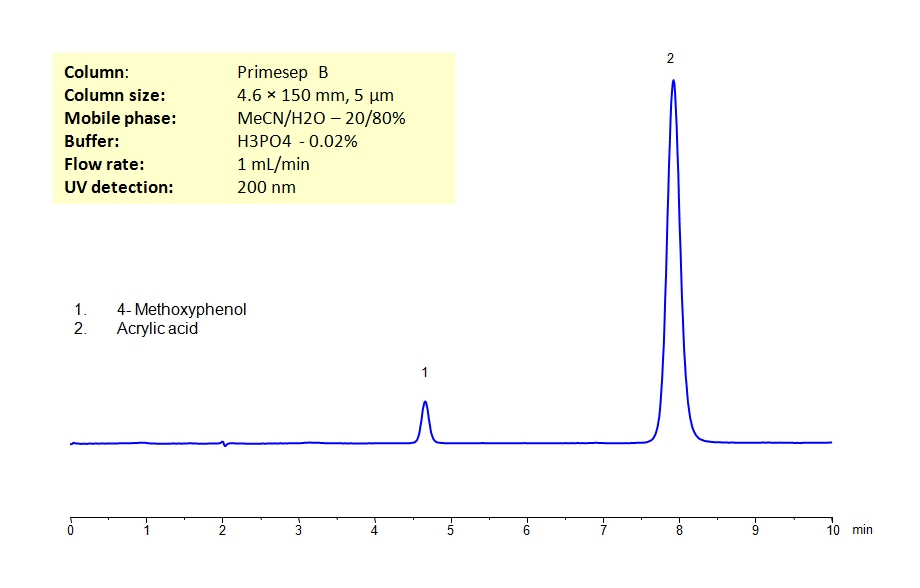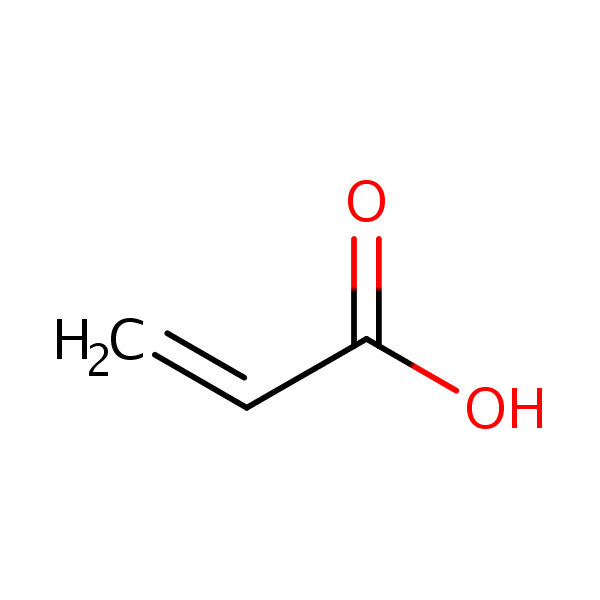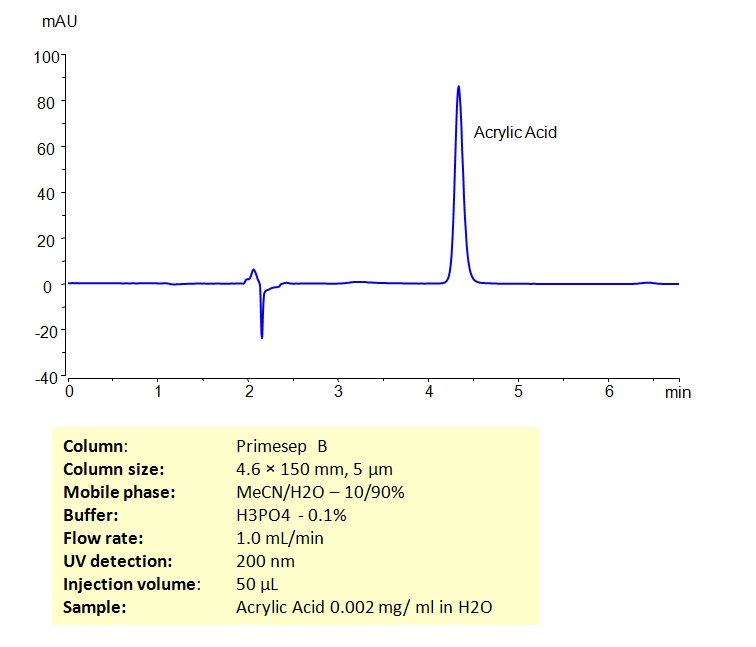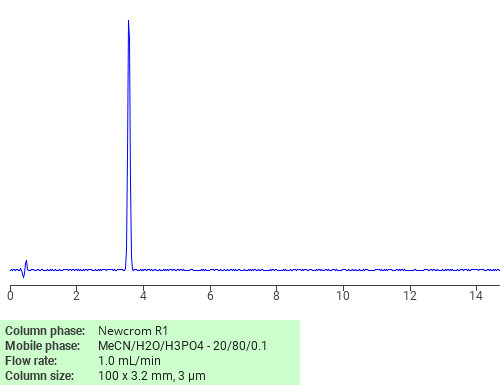| CAS Number | 79-10-7 |
|---|---|
| Molecular Formula | C3H4O2 |
| Molecular Weight | 72.063 |
| InChI Key | NIXOWILDQLNWCW-UHFFFAOYSA-N |
| LogP | 0.35 |
| Synonyms |
|
Applications:
HPLC Separation of Acrylic Acid and 4- Methoxyphenol on Primesep B Column
September 9, 2019

Acrylic acid in combination with other monomers produces copolymers which are used in manufacturing of various products such as paints, adhesives and plastics. Esters and salts of acrylic acid are known as acrylates. 4-methoxyphenol, also known as mequinol, is an active ingredient in topical drugs and is also used for inhibition of radical polymerization of monomers like acrylates. The two compounds can be separated on a mixed-mode Primesep B column with isocratic method in mobile phase of 20/80 Acetonitrile (ACN) and water with 0.02% phosphoric acid buffer. UV Detection 200nm.
Condition
Column Primesep B, 4.6×150 mm, 5 µm, 100A Mobile Phase MeCN/H2O – 20/80% Buffer H3PO4 – 0.02 % Flow Rate 1.0 ml/min Detection UV, 200 nm
Description
Class of Compounds
Acid, Hydrophilic, Ionizable, Antioxidant, Inhibitor, Phenol, Carboxylic acid Analyzing Compounds Acrylic Acid, 4- Methoxyphenol, Mequinol
Application Column
Primesep B
The Primesep family of mixed-mode columns offers a wide variety of stationary phases, boasting unprecedented selectivity in the separation of a broad array of chemical compounds across multiple applications. Corresponding Primesep guard columns, available with all stationary phases, do not require holders. SIELC provides a method development service available to all customers. Inquire about our specially-tailored custom LC-phases for specific separations.
Select optionsAcrylic acid

HPLC Determination of Acrylic Acid on Primesep B Column
September 5, 2019
HPLC Method for Acrylic acid on Primesep B by SIELC Technologies
High Performance Liquid Chromatography (HPLC) Method for Analysis of Acrylic acid
Acrylic acid, or propenoic acid, is used in a production of various copolymers for manufacturing of diverse range products. It consists of a vinyl group and a carboxylic acid. Acrylic acid can be retained on a reverse-phase (RP) mixed-mode Primesep B column in under 5 minutes. Primesep B is a reverse-phase column with embedded basic ion-pairing groups.
| Column | Primesep B |
| Mobile Phase | MeCN/H2O – 10/90% |
| Buffer | H3PO4 – 0.1 % |
| Flow Rate | 1.0 ml/min |
| Detection | UV, 200 nm |
| Class of Compounds |
Acid, Hydrophilic, Ionizable, Carboxylic acid |
| Analyzing Compounds | Acrylic acid |
Application Column
Primesep B
Column Diameter: 4.6 mm
Column Length: 150 mm
Particle Size: 5 µm
Pore Size: 100 A
Column options: dual ended

Separation of Acrylic acid on Newcrom R1 HPLC column
February 16, 2018
Acrylic acid can be analyzed by this reverse phase (RP) HPLC method with simple conditions. The mobile phase contains an acetonitrile (MeCN), water, and phosphoric acid. For Mass-Spec (MS) compatible applications the phosphoric acid needs to be replaced with formic acid. Smaller 3 µm particles columns available for fast UPLC applications. This liquid chromatography method is scalable and can be used for isolation impurities in preparative separation. It also suitable for pharmacokinetics.
Application Column
Newcrom R1
The Newcrom columns are a family of reverse-phase-based columns. Newcrom A, AH, B, and BH are all mixed-mode columns with either positive or negative ion-pairing groups attached to either short (25 Å) or long (100 Å) ligand chains. Newcrom R1 is a special reverse-phase column with low silanol activity.
Select options




